Hydropedological Characteristics of the Cathedral Peak Research Catchments
Abstract
1. Introduction
2. Materials and Methods
2.1. Study Area
2.2. Climate and Hydrological Monitoring
2.3. Hydropedology and Soil Mapping
2.4. Dominant Hydropedological Soil Groups of the Catchments
2.5. Piezometer Installations
3. Results and Discussion
3.1. Conceptual Response Based on Hydropedological Interpretations
3.2. Precipitation and Streamflow Dynamics
3.3. Piezometer Data and Flow Paths
3.3.1. CP-III
3.3.2. CP-VI
3.3.3. CP-IX
3.4. Catchment-Specific Attributes Affecting the Hydropedological Flow Paths
4. Conclusions
Author Contributions
Funding
Data Availability Statement
Acknowledgments
Conflicts of Interest
References
- Lazo, P.; Mosquera, G.; McDonnell, J.; Crespo, P. The role of vegetation, soils, and precipitation on water storage and hydrological services in Andean Páramo catchments. J. Hydrol. 2019, 572, 805–819. [Google Scholar] [CrossRef]
- Lin, H.; Brooks, E.; Mcdaniel, P.; Boll, J. Hydropedology and Surface/Subsurface Runoff Processes. In Encyclopedia of Hydrological Sciences; John Wiley & Sons, Ltd.: New York, NY, USA, 2008. [Google Scholar] [CrossRef]
- Geris, J.; Tetzlaff, D. Resistance and resilience to droughts: Hydropedological controls on catchment storage and run-off response. Hydrol. Process. 2015, 29, 4579–4593. [Google Scholar] [CrossRef]
- Pinto, L.; de Mello, C.; Darrell, N.; Poggere, G.; Owens, P.; Curi, N. A hydropedological approach to a mountainous Clayey Humic Dystrudept. Sci. Agric. 2018, 75, 60–69. [Google Scholar] [CrossRef]
- Lin, H. Hydropedology Synergistic Integration of Soil Science and Hydrology, 1st ed.; Academic Press: Cambridge, MA, USA, 2012. [Google Scholar]
- Jarvis, N.J. A review of non-equilibrium water flow and solute transport in soil macropores: Principles, controlling factors and consequences for water quality. Eur. J. Soil Sci. 2007, 58, 523–546. [Google Scholar] [CrossRef]
- Juez, C.; Nadal-Romero, E. Long-term time-scale bonds between discharge regime and catchment specific landscape traits in the Spanish Pyrenees. Environ. Res. 2020, 191, 110158. [Google Scholar] [CrossRef]
- Zhu, Q.; Castellano, M.; Yang, G. Coupling soil water processes and nitrogen cycle across spatial scales: Potentials, bottlenecks and solutions. Earth. Sci. Rev. 2018, 187, 248–258. [Google Scholar] [CrossRef]
- Lin, H. Temporal stability of soil moisture spatial pattern and subsurface preferential flow pathways in the Shale Hills Catchment. Vadose Zone J. 2006, 5, 317–340. [Google Scholar] [CrossRef]
- Novak, P. Soil Genetics in Hydropedological Survey in Mountain Areas. Soil Sci. Annu. 1986, 37, 215–223. [Google Scholar]
- Zuecco, G.; Rinderer, M.; Penna, D.; Borga, M.; van Meerveld, H.J. Quantification of subsurface hydrologic connectivity in four headwater catchments using graph theory. Sci. Total Environ. 2019, 646, 1265–1280. [Google Scholar] [CrossRef]
- Fu, Z.; Li, Z.; Cai, C.; Shi, Z.-H.; Xu, Q.; Wang, X. Soil thickness effect on hydrological and erosion characteristics under sloping lands: A hydropedological perspective. Geoderma 2011, 167, 41–53. [Google Scholar] [CrossRef]
- Juez, C.; Nadal-Romero, E.; Cammeraat, E.; Regüés, D. Spatial and temporal variability of water table dynamics in an afforested catchment of the Central Spanish Pyrenees. Hydrol. Process. 2021, 35, e14311. [Google Scholar] [CrossRef]
- Nanni, U.W. Forest Hydrological Research at the Cathedral Peak Research Station. J. South Afr. For. Assoc. 1956, 27, 2–35. [Google Scholar] [CrossRef]
- Toucher, M.L.; Clulow, A.; van Rensburg, S.; Morris, F.; Gray, B.; Majozi, S.; Everson, C.E.; Jewitt, G.P.W.; Taylor, M.A.; Mfeka, S.; et al. Establishment of a more Robust Observation Network to Improve Understanding of Global Change in the Sensitive and Critical Water Supply Area of the Drakensberg; WRC Report No. 2236/1/16; Water Research Commission: Pretoria, South Africa, 2016. [Google Scholar]
- Mucina, L.; Rutherford, M.C.; Powrie, L.W. Vegetation Map of South Africa, Lesotho and Swaziland, 2nd ed.; South African National Biodiversity Institute: Pretoria, South Africa, 2017. [Google Scholar]
- Bosch, J.M. Treatment effects on annual and dry period streamflow at Cathedral Peak. S. Afr. For. J. 1979, 108, 29–38. [Google Scholar] [CrossRef]
- Gordijn, P.J.; Everson, T.M.; O’Connor, T.G. Resistance of Drakensberg grasslands to compositional change depends on the influence of fire-return interval and grassland structure on richness and spatial turnover. Perspect. Plant Ecol. Evol. 2018, 34, 26–36. [Google Scholar] [CrossRef]
- Harrison, R.; van Tol, J. Digital Soil Mapping for Hydropedological Purposes of the Cathedral Peak Research Catchments, South Africa. In Remote Sensing of African Mountains, 1st ed.; Adelabu, S., Ramoelo, A., Olusola, A., Adagbasa, E., Eds.; Springer: Cham, Switzerland, 2022. [Google Scholar] [CrossRef]
- Everson, C.E.; Molefe, G.L.; Everson, T.M. Monitoring and Modelling Components of the Water Balance in a Grassland Catchment in the Summer Rainfall Area of South Africa; WRC Report No. 493/1/98.1998; Water Research Commission: Pretoria, South Africa, 1998. [Google Scholar]
- van Tol, J. Hydropedology in South Africa: Advances, applications and research opportunities. S. Afr. J. Plant Soil. 2020, 37, 23–33. [Google Scholar] [CrossRef]
- van Tol, J.J.; Roux, P.A.L. Hydropedological grouping of South African soil forms. S. Afr. J. Plant Soil. 2019, 36, 233–235. [Google Scholar] [CrossRef]
- Soil Classification Working Group. Soil Classification: A Natural and Anthropogenic System for South Africa; ARC-Institute for Soil, Climate and Water: Pretoria, South Africa, 2018. [Google Scholar]
- de Menezes, M.D.; Silva, S.H.G.; Owens, P.R.; Curi, N. Solum depth spatial prediction comparing conventional with knowledge-based digital soil mapping approaches. Sci. Agric. 2014, 71, 4. [Google Scholar] [CrossRef]
- Zhu, A.X.; Band, L.; Vertessy, R.; Dutton, B. Derivation of soil properties using a soil land inference model (SoLIM). Soil. Sci. Soc. Am. J. 1997, 61, 523–533. [Google Scholar] [CrossRef]
- D’Amore, D.V.; Fellman, J.B.; Edwards, R.T.; Hood, E.W.; Ping, C.L. Hydropedology of the North American coastal temperate rainforest. In Hydropedology: Synergistic Integration of Soil Science and Hydrology; Lin, H., Ed.; Academic Press: Cambridge, MA, USA, 2012. [Google Scholar]
- MacEwan, R.; Dahlhaus, P.; Fawcett, J. Hydropedology, Geomorphology, and Groundwater Processes in Land Degradation: Case Studies in South West Victoria, Australia. In Hydropedology: Synergistic integration of Soil Science and Hydrology; Lin, H., Ed.; Academic Press: Cambridge, MA, USA, 2012; pp. 449–481. [Google Scholar] [CrossRef]
- van Tol, J.J.; Le Roux, P.; Hensley, M.; Lorentz, S. Soil as indicator of hillslope hydrological behaviour in the Weatherley Catchment, Eastern Cape, South Africa. Water SA 2010, 36, 5. [Google Scholar] [CrossRef]
- Tetzlaff, D.; Birkel, C.; Dick, J.; Geris, J.; Soulsby, C. Storage dynamics in hydropedological units control hillslope connectivity, runoff generation, and the evolution of catchment transit time distributions. Water Resour. Res. 2014, 50, 969–985. [Google Scholar] [CrossRef]
- Gómez-Tagle, A. Linking hydropedology and ecosystem services: Differential controls of surface field saturated hydraulic conductivity in a volcanic setting in central Mexico. Hydrol. Earth. Syst. Sci. Discuss. 2009, 6, 2499–2536. [Google Scholar] [CrossRef]
- Pinto, L.C.; de Mello, C.R.; Owens, P.R.; Norton, L.D.; Curi, N. Role of inceptisols in the hydrology of mountainous catchments in Southeastern Brazil. J. Hydrol. Eng. 2016, 75, 60–69. [Google Scholar] [CrossRef]
- Dikinya, O.; Hinz, C.; Aylmore, G. Dispersion and re-deposition of fine particles and their effects on saturated hydraulic conductivity. Aust. J. Soil Res. 2006, 44, 47–56. [Google Scholar] [CrossRef]
- Blumstock, M.; Tetzlaff, D.; Dick, J.J.; Nuetzmann, G.; Soulsby, C. Spatial organization of groundwater dynamics and streamflow response from different hydropedological units in a montane catchment. Hydrol. Process. 2016, 30, 3735–3753. [Google Scholar] [CrossRef]
- Zimmermann, B.; Elsenbeer, H.; De Moraes, J.M. The influence of land-use changes on soil hydraulic properties: Implications for runoff generation. For. Ecol. Manag. 2006, 222, 29–38. [Google Scholar] [CrossRef]
- Zou, C.; Barron-Gafford, G.; Breshears, D. Effects of Topography and Woody Plant Canopy Cover on Near-Ground Solar Radiation: Relevant Energy Inputs for Ecohydrology and Hydropedology. Geophys. Res. Lett. 2007, 34, 24. [Google Scholar] [CrossRef]
- Granados, M.E.; Vilagrosa, A.; Chirino, E.; Vallejo, R. Reforestation with resprouter species to increase diversity and resilience in Mediterranean pine forests. For. Ecol. Manag. 2016, 362, 231–240. [Google Scholar] [CrossRef]
- Furlan, L.; Rosolen, V.; Sales, J.; Moreira, C.; Ferreira, M.; Bueno, G.; Coelho, C.; Mounier, S. Natural superficial water-storage and aquifer recharge assessment in Brazilian savanna wetland using unmanned aerial vehicle and geophysical survey. J. Unmanned Veh. Syst. 2020, 8, 224–244. [Google Scholar] [CrossRef]
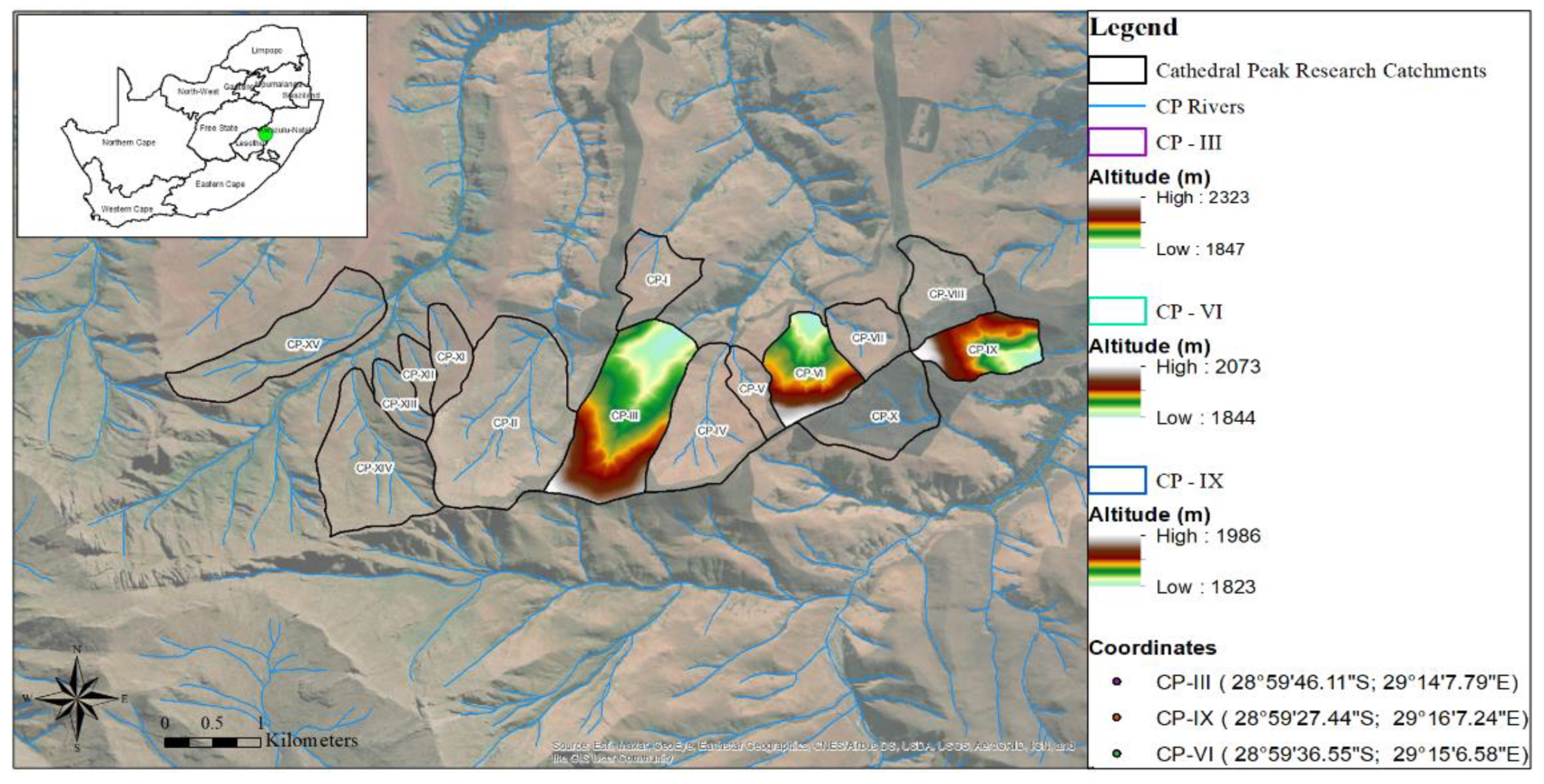
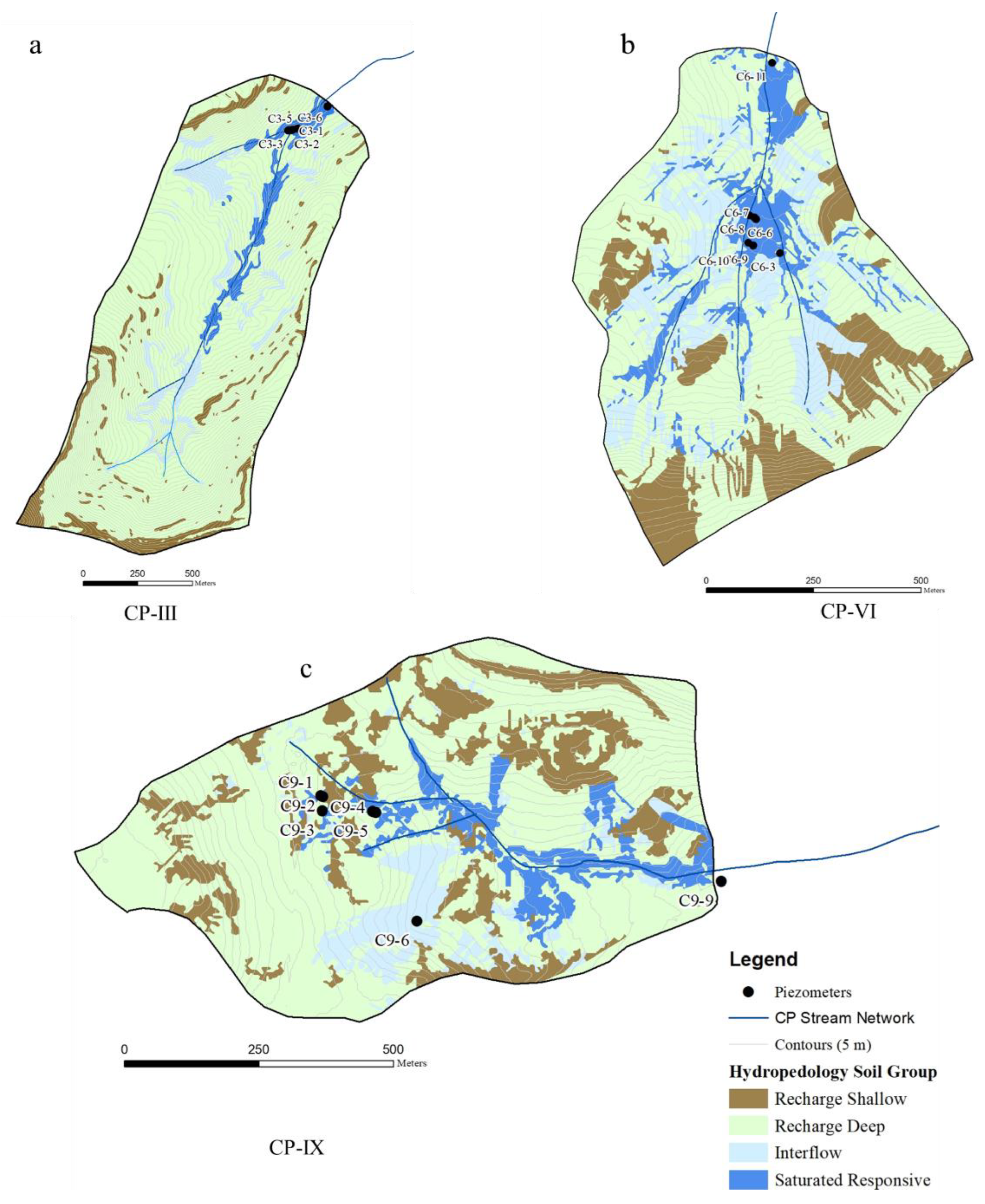
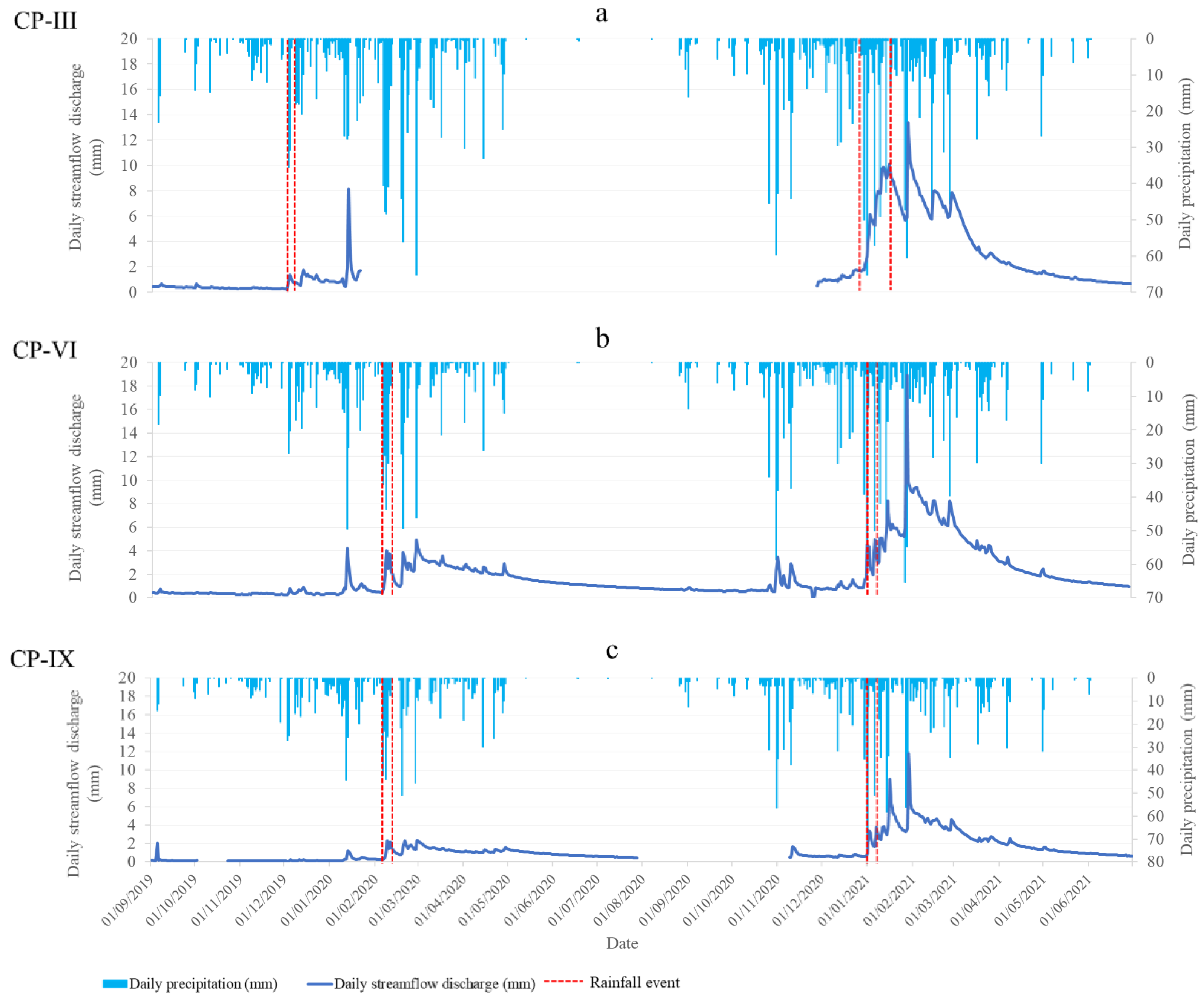
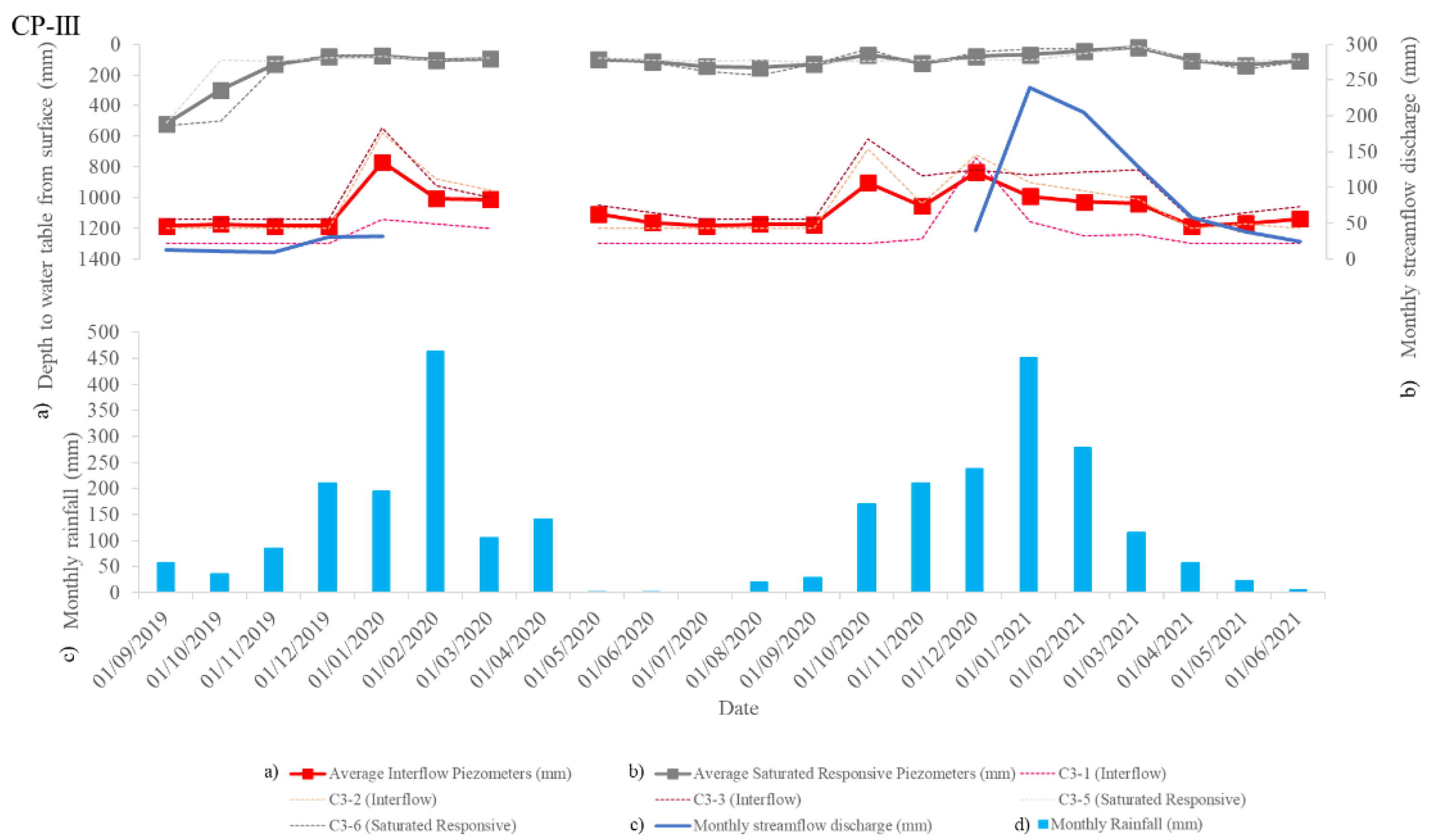

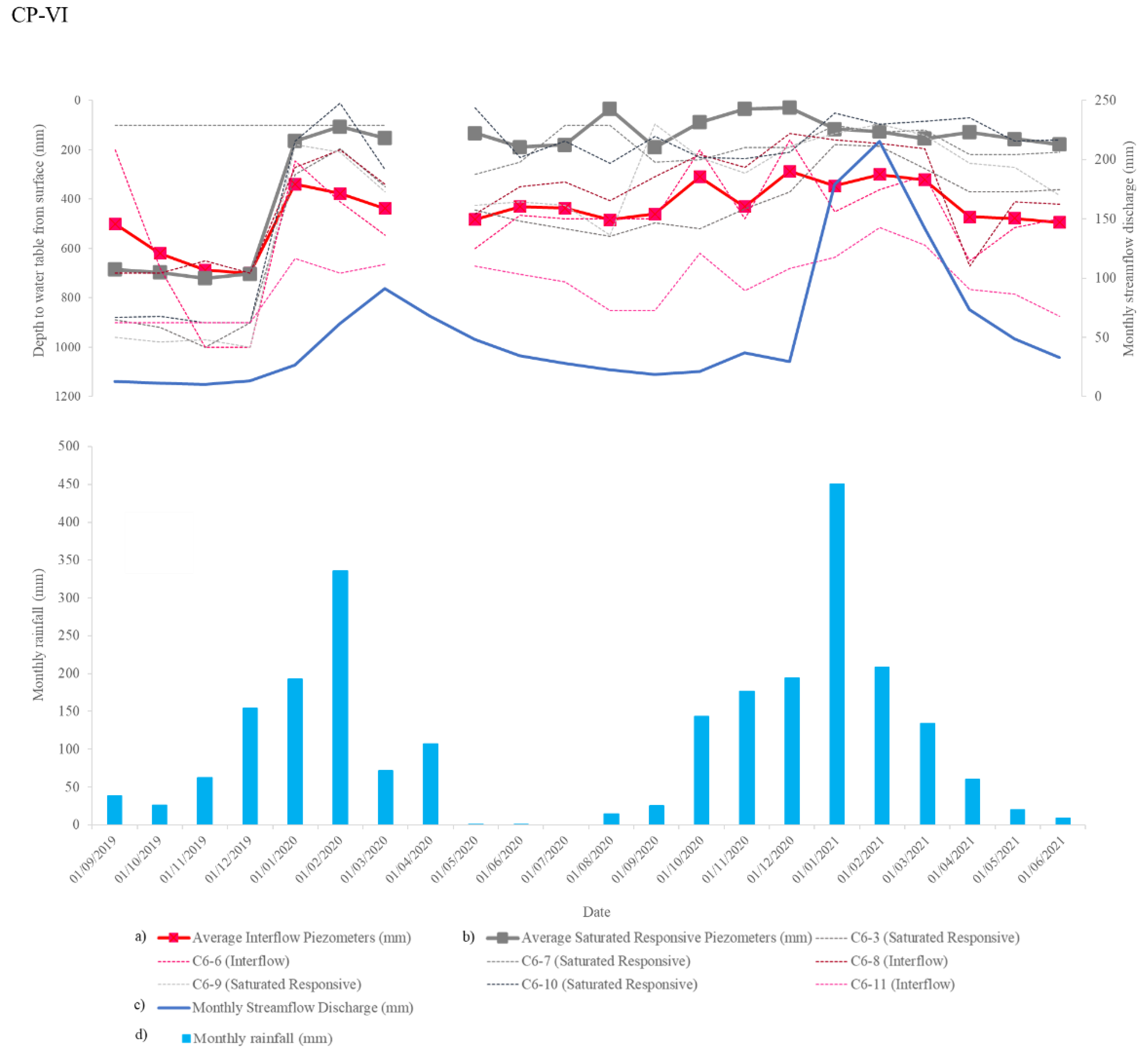
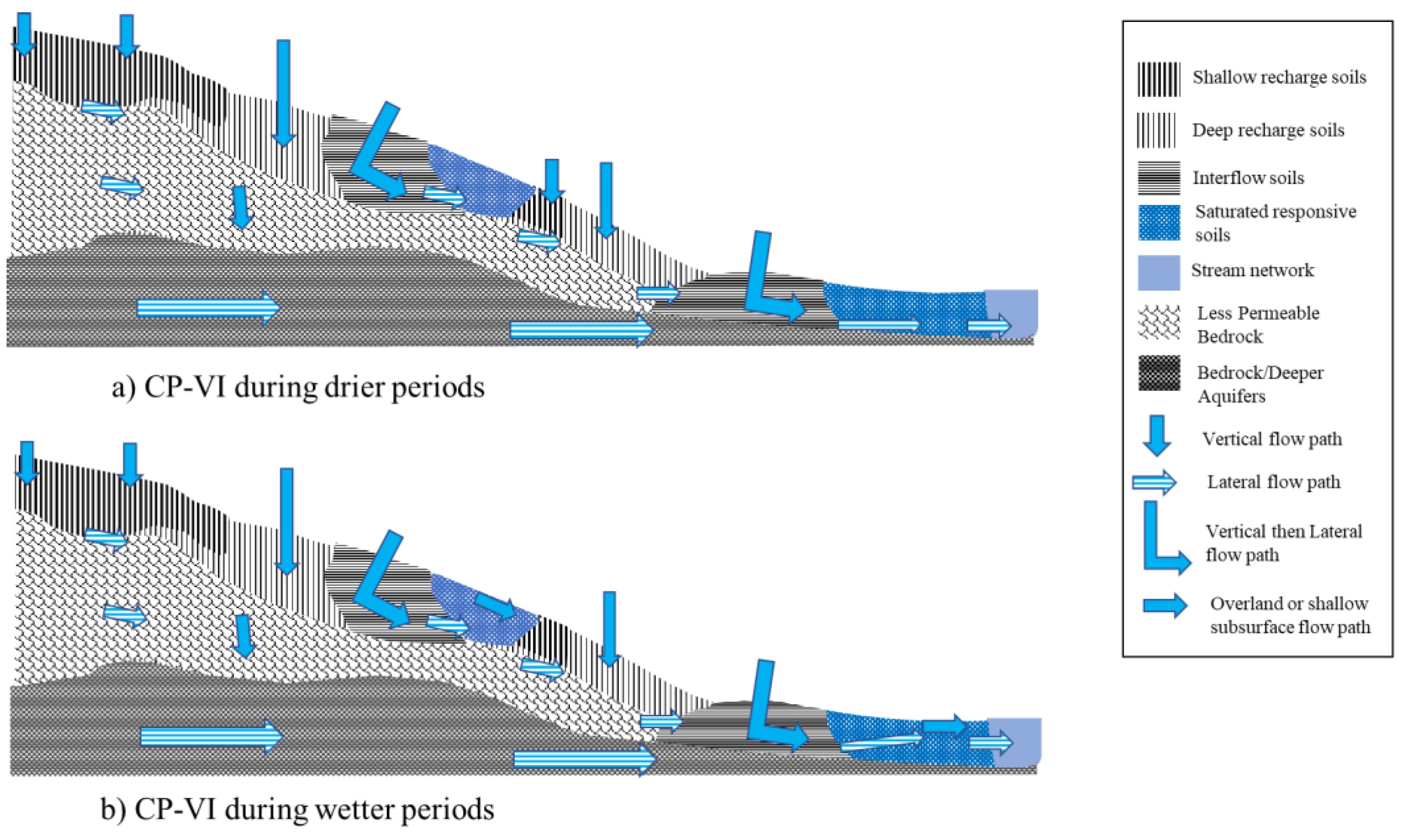
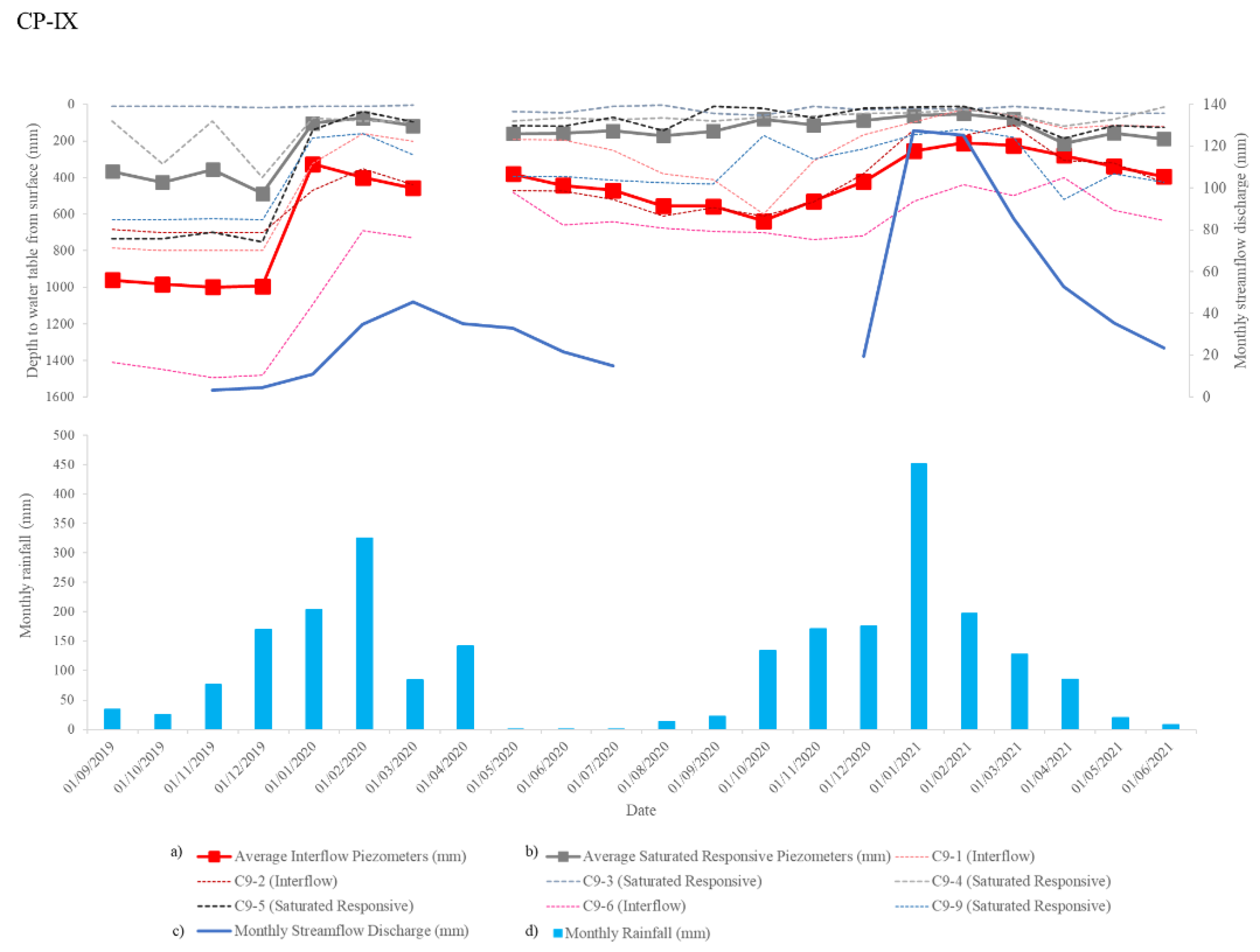
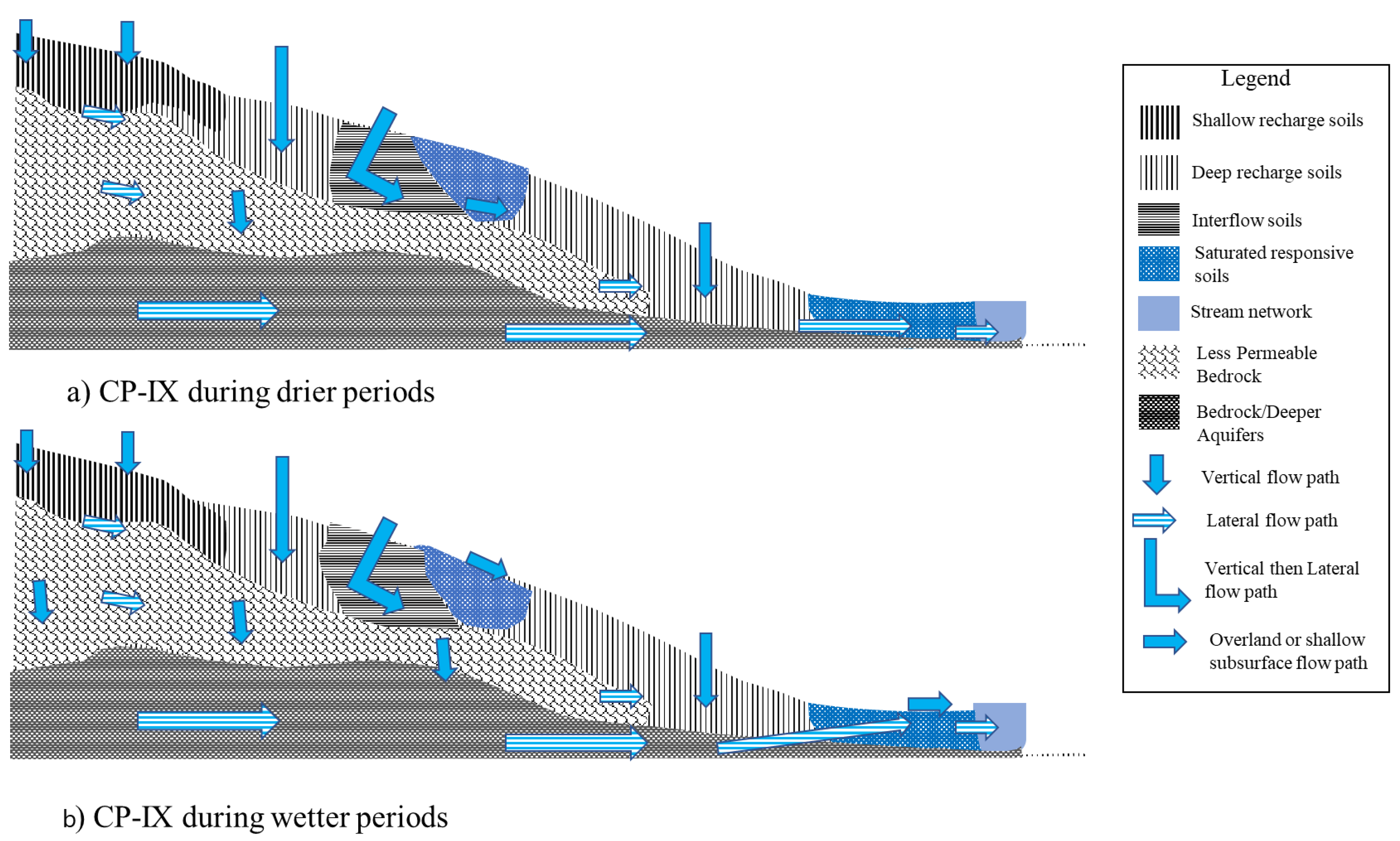
| Catchment Name | Size (ha) and Altitude Range (m.a.s.l.) | Rainfall Dynamics during Study Period | Streamflow Discharge Dynamics during Study Period | Description of Catchment |
|---|---|---|---|---|
| CP-III | 138.9 1847–2323 | Mean (mm) 4.34 Max (mm) 65.23 Min (mm) 0.00 Annual PCP 2019—1095 mm 2020—1572 mm 2021—1664 mm | Mean (mm): 2.33 Max (mm): 13.39 Min (mm): 0.22 | The catchment is degraded as a result of a forestry experiment in which Pinus patula was planted throughout the catchment in the 1950s and 1960s as well as accidental fires which led to the removal of these trees in 1981. The catchment was rehabilitated with Eragrostis curvula following the removal of the trees [15]. There is, however, erosion throughout the catchment area, with large portions of the catchment covered by Pteridium sp. (Bracken). |
| CP-VI | 67.7 1844–2073 | Mean PCP (mm) 3.62 Max PCP (mm) 65.28 Min (PCP) (mm) 0.00 Annual PCP 2019—829 mm 2020—1261 mm 2021—1472 mm | Mean (mm): 1.84 Max (mm): 18.90 Min (mm): 0.00 | This catchment is covered by mesic grassland of the uKhahlamba Basalt Grassland type which is burned biennially during spring. CP-VI is considered the core catchment with focused, detailed monitoring ongoing in this catchment. A full array of evaporation, soil moisture and groundwater monitoring is undertaken. |
| CP-IX | 64.5 1823–1966 | Mean PCP (mm) 3.70 Max PCP (mm) 68.34 Min (PCP) (mm) 0.00 Annual PCP 2019—884.94 mm 2020—1274 mm 2021—1378 mm | Mean (mm): 1.28 Max (mm): 11.81 Min (mm): 0.09 | This catchment has been completely protected from fire since 1952 but has experienced accidental burns and wildfires in some years. As a result of fire exclusion, this catchment is dominated by woody scrub (Leucasidea serica and Buddleia salvifolia). |
| Hydropedological Soil Group | Characteristics of the Soils |
|---|---|
| Recharge Shallow | These are soils that are freely drained and do not show any indication of saturation. They are typically shallow in nature (<500 mm). The freely drained B horizon merges with fractured rock or a lithic horizon. These soils typically occur on steeper convex slopes in the higher lying or steeper parts of the catchments. |
| Recharge Deep | These are soils that are freely drained and do not show any indication of saturation. They are typically deeper than the Recharge Shallow Soils (>500 mm). The freely drained B horizon merges into fractured rock or a lithic horizon. These soils where identified throughout the catchments on gentler convex and concave slopes and away from wetlands and watercourses. |
| Interflow | These soils have a freely drained upper solum which overlies relatively impermeable bedrock. Hydromorphic properties are identified at this interface and signify periodic saturation associated with a water table. They typically occur on gentler concave slopes in areas delineated as wetlands as well as adjacent to watercourses. |
| Responsive Saturated | These soils display morphological indications of long-term saturation. They characteristically respond quickly to rainfall events and generate overland flow as they are typically close to saturation during the wet season and therefore any additional precipitation will flow overland due to saturation excess. These soils were identified in the valley bottom positions of the catchments, in permanently saturated wetlands. They typically occur on gentle concave slopes. |
| CP-III | CP-VI | CP-IX | |
|---|---|---|---|
| Hydropedological soil group | Percentage of catchment covered by each hydropedological soil group | ||
| Recharge Shallow | 18.3 | 17.1 | 27.6 |
| Recharge Deep | 43.3 | 33.8 | 38.4 |
| Interflow | 24.1 | 28.7 | 15.9 |
| Responsive Saturated | 14.3 | 20.4 | 18.1 |
Publisher’s Note: MDPI stays neutral with regard to jurisdictional claims in published maps and institutional affiliations. |
© 2022 by the authors. Licensee MDPI, Basel, Switzerland. This article is an open access article distributed under the terms and conditions of the Creative Commons Attribution (CC BY) license (https://creativecommons.org/licenses/by/4.0/).
Share and Cite
Harrison, R.; van Tol, J.; Amiotte Suchet, P. Hydropedological Characteristics of the Cathedral Peak Research Catchments. Hydrology 2022, 9, 189. https://doi.org/10.3390/hydrology9110189
Harrison R, van Tol J, Amiotte Suchet P. Hydropedological Characteristics of the Cathedral Peak Research Catchments. Hydrology. 2022; 9(11):189. https://doi.org/10.3390/hydrology9110189
Chicago/Turabian StyleHarrison, Rowena, Johan van Tol, and Philippe Amiotte Suchet. 2022. "Hydropedological Characteristics of the Cathedral Peak Research Catchments" Hydrology 9, no. 11: 189. https://doi.org/10.3390/hydrology9110189
APA StyleHarrison, R., van Tol, J., & Amiotte Suchet, P. (2022). Hydropedological Characteristics of the Cathedral Peak Research Catchments. Hydrology, 9(11), 189. https://doi.org/10.3390/hydrology9110189










